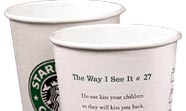 Is it me – or is Starbucks becoming more and more like a great radio station? Or the kind of station we’d all want to work for?
Is it me – or is Starbucks becoming more and more like a great radio station? Or the kind of station we’d all want to work for?
After I bought some shares of their stock, they sent me a special “shareholders card,” loaded up with $3.50. Every time I use it (yes, I loaded it up with cash), I am greeted as someone special at every Starbucks store I visit. They recognize me not just as a customer, but as someone who has invested in their business (or the Super P1 that I am).
They do more than serve coffee (i.e., play music) because I can get cheaper coffee at Dunkin’ Donuts or the equivalent at Caribou. Starbucks stores have a vibe, a lifestyle, and an atmosphere. Their people are always friendly, the music is interesting (which is why they are successfully selling tons of it), and they understand that their business is about more than selling mochas. They make their customers feel wanted and comfortable in a world that is frantic, inconsistent, and often unsettling.
Like NPR, Starbucks understands they are not just providing beverages to their customers, but are tapping into the core values of their guests. Aspects of these values include charity, environmental concerns, and technology (music downloading, XM channel, etc.), and deepen their relationships, and bind them emotionally to the brand.

The newest innovation is “The Way I See It“ series that’s printed on their cups. These are clever, thoughtful quotes from everyone from Keith Olbermann to Al Franken to Goldie Hawn to Ken Burns. And now they are “peopletizing” this series by inviting customers to submit their own sayings and thoughts, some of which will show up on future cups (like “Guest DJ” done right). What a grande concept!
- Can Radio Win “The Last Touch/First Touch Challenge?” - April 4, 2025
- How Will Radio Fare In The Battle For The Fourth Screen? - April 3, 2025
- Like A Pair Of Old Jeans - April 2, 2025




Let’s be honest…all restaurant’s have “good food.” (or at least most of them) In order to be successful in the restaurant business one must go beyond the basic “good food” premise. And while a few restaurants can perhaps sell “cheap” or “inexpensive” food, the real winners serve up a concept built around the food. Red Lobster gets decent dollars for a plate of shrimp sauted in butter & garlic. Olive Garden commands $12 for a plate of noodles and sauce that one can make at home for about a buck. And people stand in line and wait, for the priviledge to be served at these establishments. And that’s where understanding the patron comes into play.
Let’s look at radio. We all play “good music,” but what do we do beyond that? I guess radio stations can start playing the quantity game, but they will never beat commercial-free XM, Sirius or the Ipod.
Some success stories in music radio over the years include Delilah who goes beyond just playing sappy love songs…she includes sappy phone calls that reach out and touch the audience. How about Casey Kasem’s American Top 40. Sure it’s a countdown show of the top hits…but Kasem researched the songs, the artists and the writers who brought those songs to the recording studio and wrote a “story” about some of the songs he was playing on that program. Something you could not get elsewhere on the radio dial.
Radio should take a cue from the restaurant business. And no, it’s not about the McDonaldization of radio. It’s about being successful in a highly competitive business.
There is a reason some restaurants charge $1 for a hamburger and elsewhere you can get that same burger for $7.95, and people stand in line to pay that. There’s a reason that restaurants serve Heineken’s in a bottle and not a glass. And there’s a reason Lobster is listed on the menu at “market price.” A successful radio programmer knows why, and realizes to win the “patron” or in our case the “listener” he/she has to go beyond just serving up “good music.”